As a final tune-up before the Gorge Downwind Championships, I had to make this year’s Jamestown Double Beaver count. I was feeling pretty good about my stamina – this would mark my seventh race of the season – but my technique has been sloppy. Rather than pushing myself to new heights, I’d been falling back on lazy habits from past years. I’d have to swing for the fences. Damn it! Cliche. Next thing you know, I’ll be throwing in a filler joke at Bill Kuklinski’s expense. Or leading my readers down one path, only to unexpectedly flip the meaning around. And in such a clumsy fashion that I’ll have to explain that I’ve been referring to writing rather than racing. It’s OK, Lesher, just get it out of your system now.
Since race director Tim Dwyer would be heading out the next day for a hectic schedule of racing in the Pacific Northwest, he opted to shorten the course slightly to an even ten miles. We’d head out from the dock of Conanicut Yacht Club, cross Jamestown Harbor, pass the House on the Rock and Fort Wetherill, slice diagonally across the bottom of Conanicut Island to the Beavertail can, then reverse our course. Jamestown local Bob Wright indicated that earlier in the day there had been a little bump off Beavertail. With winds increasing from the southeast throughout the day, we could expect slightly more challenging conditions by the time we got to the turn-around.
Surveying the field of 16 paddlers, I found myself in a classic Goldilocks situation. If it was too rough, downwind glutton Eric Costanzo would eat my porridge. If it was not rough enough, flatwater whiz Mike Dostal would, uh… short-sheet my bed? I could only pray that the race would go better than this dead-end analogy.
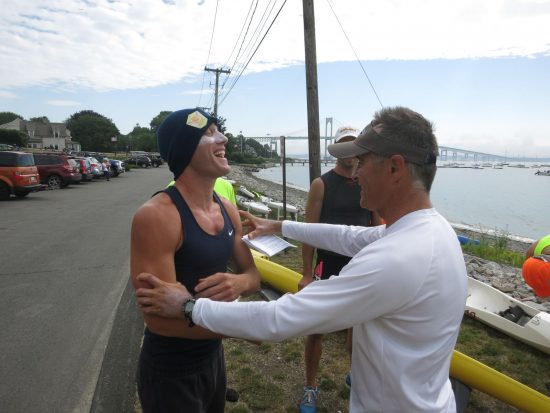
Nobody’s really comfortable with Tim’s pre-race “Tickle Test”, but it’s a long-standing Double Beaver tradition.
Once Tim had briefed us on the course and absolved us of our sins (just in case), we hit the water. At the Sakonnet River Race, I had let Mike get away at the start and spent the next 45 minutes trying to close the gap he had established in the first half mile. That chase turned out to be fruitless, of course, since after I caught him, he proceeded to open up a new and lethal lead. At Jamestown I was determined to limit the number of times I watched impotently as Mike receded into the distance to just once. Upon further reflection, it would have been easier to just get that over with at the start and then not bother trying to catch him, but at the time it seemed important that I hang on for at least a token span after the gun. I couldn’t. Fortunately, Eric and Andrius Zinkevichus could. Through a series of desperate lunges, I managed to catch on Andrius’ wash. I warmed up in the on deck position for a moment before sliding into home base of a diamond draft pattern.
I had just tucked my paddle under the bungees in preparation for a quick nap when Andrius got picked off at first base, causing our now-unstable diamond to collapse into a line – Mike, Eric, me, then Andrius. A few moments later, when it looked like Eric’s dedication to keeping me in contact with Mike might be wavering, I pulled ahead into the second slot. That’s how we stayed until reaching the House on the Rock. With teary promises to write one another, we separated to pursue our individual destinies.
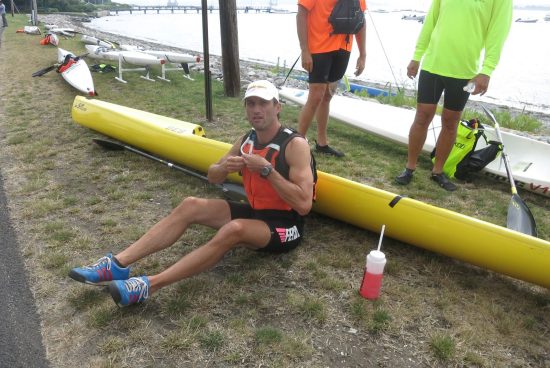
Just seeing the gentle waves in Jamestown Harbor, Mike felt so woozy he had to take a seat.
Tim had coerced his son Finn into photographing the race for posterity from the Dwyer runabout. “For posterity” is usually just an expression, but if past Jamestown races were any example, no currently living human would ever see these pictures. We can only hope that some historian will uncover them in the far future, using them to bolster his controversial theories regarding the geriatric hobbies of early 21st century New Englanders. Up ahead, the camera boat awaited the approach of the lead pack.
I’ve always been confounded by those competitors who always manage to throw a jaunty smile the way of the photographer. Mid-race pictures of Francisco Urena at the Blackburn, for example, always look like something torn from an adventure-oriented sportswear catalog. Photos of me, on the other hand, are used in training manuals to desensitize battlefield medics. Ancient Egyptians used a hook to remove the brains through a pharaoh’s nose prior to mummification. In race photos, my expression looks like I suddenly woke up during such a process. Since Francisco wasn’t there for his glamour shot, I decided to do my best to emulate his example. Lacking the raw materials (as Mary Beth is fond of reminding me), I was really going to have to sell it. As I passed the camera boat, I dialed the charm up to 11.
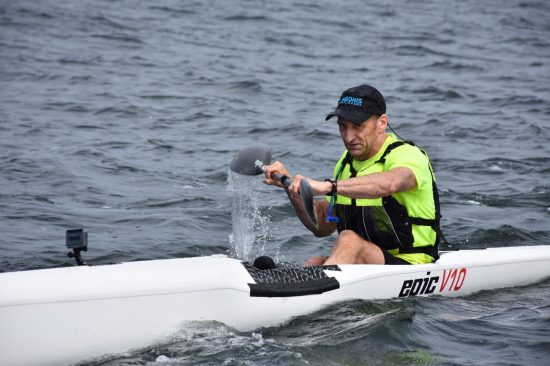
(Photo courtesy of Finn Dwyer’s distant descendants)
I think you’ll agree… I was looking in the general direction of the camera. Now get out there and save some lives!
After rounding Bull Point, we had to haul ourselves upwind on the 3.5 mile open-water trek to the Beavertail can. With no real hope of ducking out of the headwind, the smart navigation choice was to take a direct line. Or – even better – to swing out wide left to catch a ride on the outgoing tide. Seeing a chance to seize home field advantage prior to the race, Wesley had cleverly dissuaded competitors from choosing this option by loudly mocking the “clueless losers” that had taken a similar line in 2016. He may not have used those exact words, but I, for one, was not going to risk belittlement at next year’s race. I tried to stay on a straight line, but my GPS shows that I consistently drifted right to avoid Wesley’s scorn.
Mike started out even more skittish, staying closer to shore. Emboldened by my example, however, he soon angled over to join me. Paddling side by side (ish) over the next three miles, I found it increasingly difficult to understand why Mike refused to yield to my characterization of him as a fair-weather, flat-water, fancy-pants ICF paddler incapable of managing real ocean conditions. The sea was getting livelier by measure as we approached the Beavertail can, yet there he was, doing a serviceable impression of an actual surfskier. The other possibility – that we were equally deficient in rough water skills – briefly crossed my mind, but was dismissed by my ego as ludicrous twaddle. After all, isn’t nearly 5% of my training on the ocean?
As Mike rounded the can a couple of lengths ahead, I graciously conceded that he was nearly as fast as me in confused upwind conditions. But downwind… surely that’s where the men would be separated from the boys. And, seeing Eric’s predatory V12 take the turn less than a minute behind us, I feared both Mike and I might be the ones marched off to the iPad factory. From repeated examples, I know how fast Eric can close a downwind gap.
After the turn, it seemed that Mike’s facade of ocean competence might be cracking. I managed to catch a few runners and pull a couple of lengths ahead. The natural order was being restored. Confidence swelling, I started calculating how much of a lead would be sufficient to hold off Mike once we reached the calm waters of Jamestown Harbor. While struggling with the long division, I looked up to notice that I was no longer in the lead. This, of course, simplified the problem. With Mike slowly pulling away over the course of the next mile, I could concentrate all of my efforts on holding off Eric.
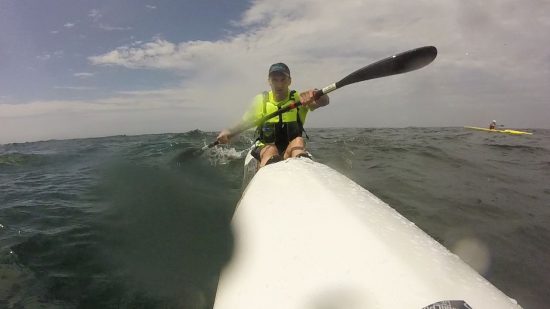
Based on this one instant from my GoPro video, you should go ahead and assume that I spent quite a bit of time in the lead.
Although there were plenty of runs to be had, the opposing tidal current siphoned most of the satisfaction from them. My treasonous GPS was all but ignoring my surfing efforts, registering a consistently sluggish pace whenever I glanced down. Panic was setting in. I expected to see Eric nose into view at any moment, and started calculating how much of a handicap I could afford to grant him entering the flat final stretch. Despite triple-checking the math, the answer kept coming out “diddly-squat”. Given how easily Eric had stayed with Mike and me on the outward leg in Jamestown Harbor, I couldn’t count on out-distancing him on the return.
I never caught sight of Eric behind me, but he told me afterwards that he had closed to within a few lengths on the downwind. With Mike perhaps a minute ahead, I rounded Bull Point and passed by the House on the Rocks. I thought I might be able to make up a little time by plotting a course through the mooring field rather than skirting outside as Mike was doing, but ended up ceding another 30 seconds in the final mile. Eric finished less than 45 seconds behind me, followed soon after by disturbingly-poised rookie Chris Quinn. Reaping the benefits of his Blackburn training program (and having reserved the best navigational lines for his personal use), Wesley took fifth place. Mary Beth swept the women’s division, while John Redos took home the OC-1 crown.
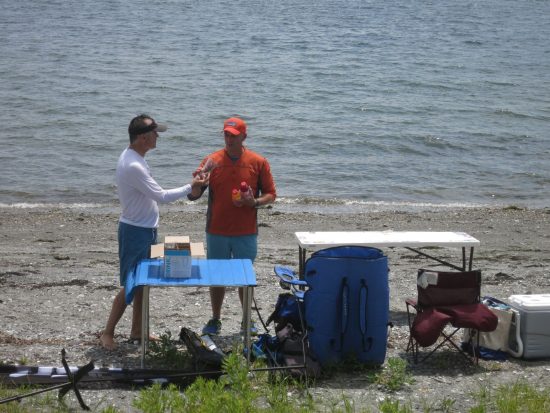
In a private awards ceremony, Eric was promoted to Vice Admiral of Beverages.
All other things being equal, I’d have little choice but to formally rescind all the defamatory statements I’ve published about Mike’s open-water abilities. And also a bunch I’ve written on motivational Post-It notes around the house. However… After the race, Mike asked me how hard I was able to push during the rougher portion of the race. When I answered “90 to 95%”, the crest-fallen look on his face revealed the bitter truth. His effort was much lower! Mike was more unstable in conditions, but he’s got so much extra power that he still trounced me. I’m not sure exactly why I should take solace in this, but I do. And all my previous statements still stand!
Tim and Bob had prepared engraved pint glasses for all the participants. And since you can’t spell “laser-etched” without “lesher”, the design thoughtfully included my silhouette. I’m truly touched by the gesture. And I assume the royalty check is in the mail. With pizza, chips, cookies, and shandies flowing liberally on the beach, the after-party quickly deteriorated into a wrestling match for the door prizes generously donated by Epic. Mary Beth and I fight dirty, so we walked away with a new paddle, a $100 gift certificate, and two of Kirk Olsen’s toes.
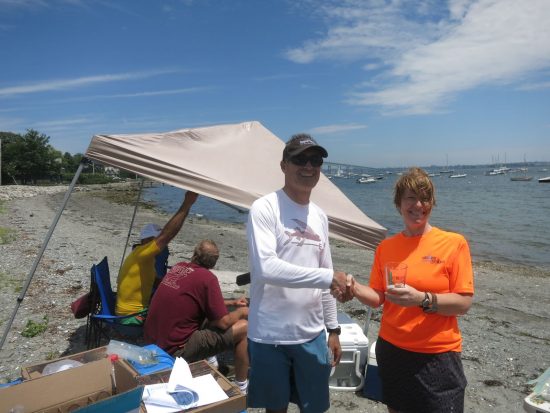
I captured this picture just seconds before Andrius was whisked away.
Thanks to Tim and family. They’ve yet to learn that if they keep treating the paddling community so well, we’re just going to keep dropping in. Like, say, in three weeks. Dibs on the sun room!
While some of us will be heading out to Oregon to race in the Gorge, the Blackburn Challenge beckons the rest. You can still register through July 19. While you’ve got that credit card out, might as well preregister at PaddleGuru for the Battle of the Bay on July 29 (at $15 it’s the bargain of the season). And since you’re now officially on a spending spree, you’ll want to sign up for Sean Rice’s half-day Saturday clinic or full-day advanced Sunday clinic. Details at PaddleLife, registration at Eventzilla.
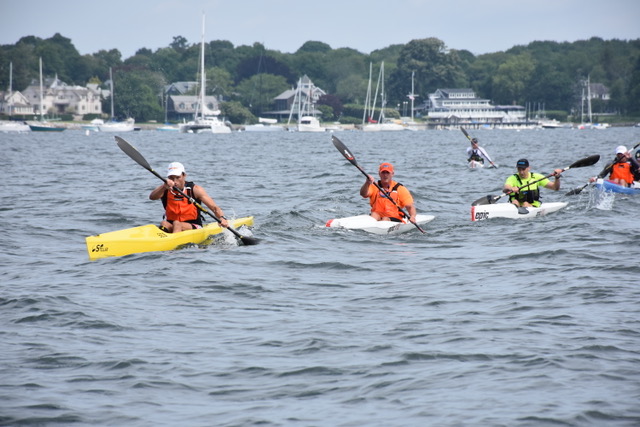
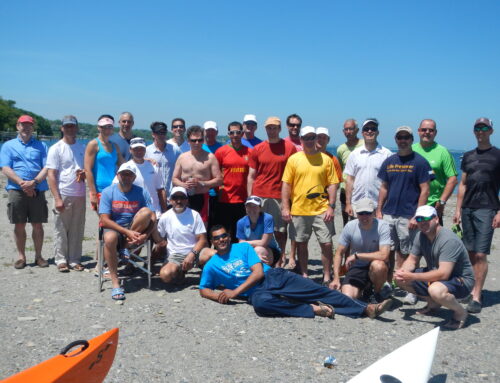
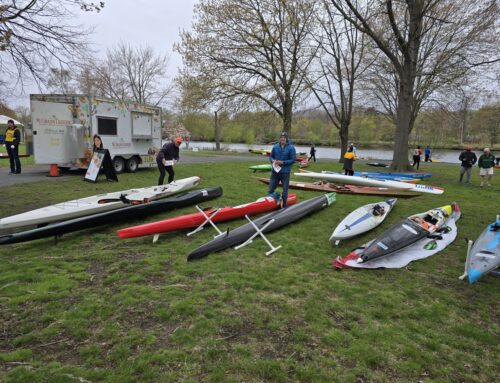
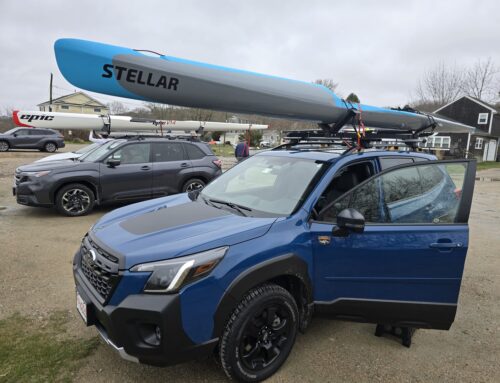
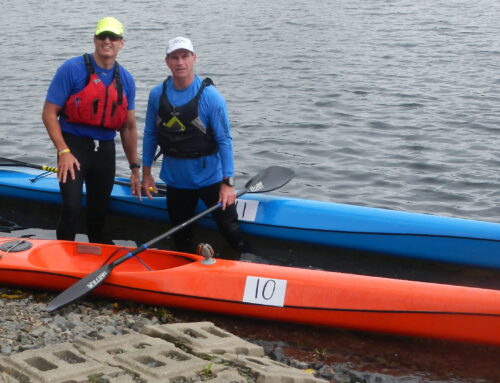
Leave A Comment
You must be logged in to post a comment.